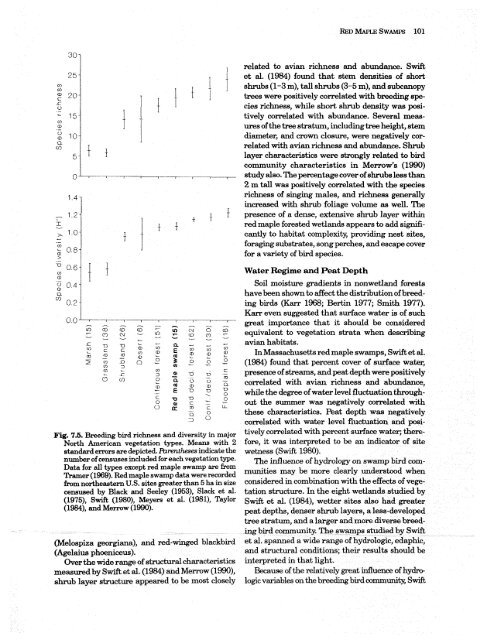Ecology of Red Maple Swamps in the Glaciated Northeast: A ...
Ecology of Red Maple Swamps in the Glaciated Northeast: A ...
Ecology of Red Maple Swamps in the Glaciated Northeast: A ...
You also want an ePaper? Increase the reach of your titles
YUMPU automatically turns print PDFs into web optimized ePapers that Google loves.
elated to avian richness and abundance. Swift<br />
et al. (1984) found that stem densities <strong>of</strong> short<br />
shrubs (1-3 m), tall shrubs (3-5 m), and subcanopy<br />
trees were positively correlated with breed<strong>in</strong>g species<br />
richness, while short shrub density was positively<br />
correlated with abundance. Several measures<br />
<strong>of</strong> <strong>the</strong> tree stratum, <strong>in</strong>clud<strong>in</strong>g tree height, stem<br />
diameter, and crown closure, were negatively correlated<br />
with avian richness and abundance. Shrub<br />
layer characteristics were strongly related to bird<br />
community characteristics <strong>in</strong> Merrow's (1990)<br />
study also. The percentage cover <strong>of</strong> shrubs less than<br />
2 m tall was positively correlated with <strong>the</strong> species<br />
richness <strong>of</strong> s<strong>in</strong>g<strong>in</strong>g males, and richness generally<br />
<strong>in</strong>creased with shrub foliage volume as well. The<br />
presence <strong>of</strong> a dense, extensive shrub layer with<strong>in</strong><br />
red maple forested wetlands appears to add significantly<br />
to habitat complexity, provid<strong>in</strong>g nest sites,<br />
forag<strong>in</strong>g substrates, song perches, and escape cover<br />
for a variety <strong>of</strong> bird species.<br />
Fig. 7.6. Breed<strong>in</strong>g bird richness and diversity <strong>in</strong> major<br />
North American vegetation types. Means with 2<br />
standard errors are depicted. Paren<strong>the</strong>ses <strong>in</strong>dicate <strong>the</strong><br />
number <strong>of</strong> censuses <strong>in</strong>cluded for each vegetation type.<br />
Data for all types except red maple swamp are from<br />
Tramer (1969). <strong>Red</strong> maple swamp data were recorded<br />
from nor<strong>the</strong>astern U.S. sites greater than 5 ha <strong>in</strong> size<br />
censused by Black and Seeley (1953)' Slack et al.<br />
(1975), Swift (1980), Meyers et al. (1981), Taylor<br />
(1984), and Merrow (1990).<br />
(Melospiza georgiana), and<br />
(Agelaius phoeniceus).<br />
Over <strong>the</strong> wide range <strong>of</strong> structural characteristics<br />
measured by Swift et al. (1984) and Merrow (lw),<br />
shrub layer structure appeared to be most closely<br />
Water Regime and Peat Depth<br />
Soil moisture gradients <strong>in</strong> nonwetland forests<br />
have been shown to affect <strong>the</strong> distribution <strong>of</strong> breed<strong>in</strong>g<br />
birds (Karr 1968; Bert<strong>in</strong> 1977; Smith 1977).<br />
Karr even suggested that surface water is <strong>of</strong> such<br />
great importance that it should be considered<br />
equivalent to vegetation strata when describ<strong>in</strong>g<br />
avian habitats.<br />
In Massachusetts red maple swamps, Swift et al.<br />
(1984) found that percent cover <strong>of</strong> surface water,<br />
presence <strong>of</strong> streams, and peat depth were positively<br />
correlated with avian richness and abundance,<br />
while <strong>the</strong> degree <strong>of</strong> water level fluctuation tihroughout<br />
<strong>the</strong> summer was negatively correlated with<br />
<strong>the</strong>se characteristics. Peat depth was negatively<br />
wrrelated with water level fluctuation and positively<br />
correlated with percent surface water; <strong>the</strong>refore,<br />
it was <strong>in</strong>terpreted to be an <strong>in</strong>dicator <strong>of</strong> sib<br />
wetness (Swift 1980).<br />
The <strong>in</strong>fluence <strong>of</strong> hydrology on swamp bird communities<br />
may be more clearly understood when<br />
considered <strong>in</strong> comb<strong>in</strong>ation with <strong>the</strong> effects <strong>of</strong> vegetation<br />
structure. In <strong>the</strong> eight wetlands studied by<br />
Swift et al. (1984), wetter sites also had greater<br />
peat depths, denser shrub layers, a less-developed<br />
tree stratum, and a larger and more diverse breed<strong>in</strong>g<br />
bird community. The swamps studied by Swift<br />
et al, spanned a wide range <strong>of</strong> hydrologic, edaphic,<br />
and structural conditions; <strong>the</strong>ir results should be<br />
<strong>in</strong>terpreted <strong>in</strong> that light.<br />
Because <strong>of</strong> <strong>the</strong> relatively great <strong>in</strong>fluence <strong>of</strong> hydrologic<br />
variables on <strong>the</strong> breed<strong>in</strong>g bird community, Swift

















